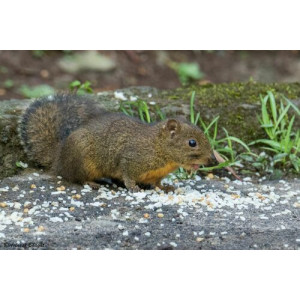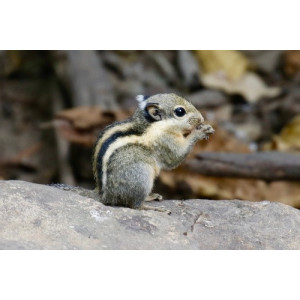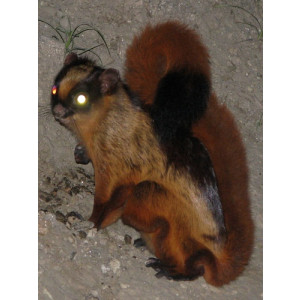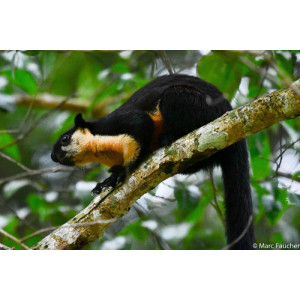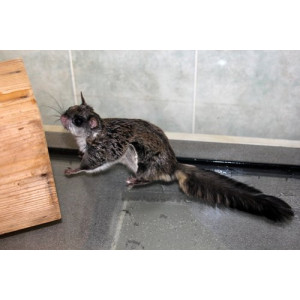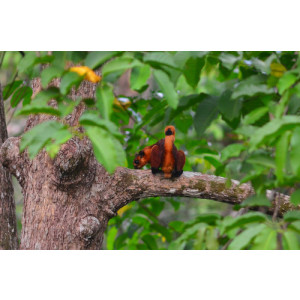Irrawaddy Squirrel Did you see this animal?
Scientific Name : Callosciurus pygerythrus
Family : Sciuridae
Order : Rodentia
Class : Mammalia
Phylum : Chordata
Other Name : Hoary-bellied Himalayan Squirrel
Habitat : Forest, Shrubland
Description : The Irrawaddy squirrel is a relatively large species, with an average body length of around 30-40cm and a weight of up to 1.5kg. Their fur is soft and dense, and typically ranges in color from a grayish-brown to a reddish-brown on their upper body, while their underbelly is a cream or white color. They have a long bushy tail, which can reach up to 50cm in length and is often used for balance when moving through the trees.
These squirrels are known for their agility and acrobatic abilities, which they use to navigate through the canopy of trees where they make their home. They are excellent climbers and jumpers, and are able to make leaps of up to 3 meters between trees. They have sharp claws that allow them to grip onto tree trunks and branches with ease, and their long, muscular hind legs enable them to run quickly and efficiently along tree branches.
Irrawaddy squirrels are primarily herbivorous, with their diet consisting mainly of fruits, seeds, and nuts. They have also been known to feed on insects and small invertebrates when other food sources are scarce. These squirrels are diurnal, meaning that they are active during the day, and they spend most of their time in the trees, only descending to the ground occasionally to search for food or to move between trees.
Irrawaddy squirrels are typically solitary animals, but they have been observed in pairs or small family groups during breeding season. They communicate with each other through a variety of vocalizations and body language, including tail flicking and ear movement.
Female Irrawaddy squirrels typically give birth to a litter of 2-3 young, which they raise in a nest made of leaves and twigs. The young are born blind and hairless, and rely on their mother's milk for the first few weeks of life.
The average lifespan of an Irrawaddy squirrel is not well documented, but some reports suggest they can live up to 10 years in the wild
The Irrawaddy squirrel is considered to be of least concern by the International Union for Conservation of Nature (IUCN) due to its wide distribution and relatively stable population. However, they are still threatened by habitat loss due to deforestation, as well as hunting for their meat and fur. Efforts are being made to protect their natural habitat and prevent further decline in their population.
These squirrels are known for their agility and acrobatic abilities, which they use to navigate through the canopy of trees where they make their home. They are excellent climbers and jumpers, and are able to make leaps of up to 3 meters between trees. They have sharp claws that allow them to grip onto tree trunks and branches with ease, and their long, muscular hind legs enable them to run quickly and efficiently along tree branches.
Irrawaddy squirrels are primarily herbivorous, with their diet consisting mainly of fruits, seeds, and nuts. They have also been known to feed on insects and small invertebrates when other food sources are scarce. These squirrels are diurnal, meaning that they are active during the day, and they spend most of their time in the trees, only descending to the ground occasionally to search for food or to move between trees.
Irrawaddy squirrels are typically solitary animals, but they have been observed in pairs or small family groups during breeding season. They communicate with each other through a variety of vocalizations and body language, including tail flicking and ear movement.
Female Irrawaddy squirrels typically give birth to a litter of 2-3 young, which they raise in a nest made of leaves and twigs. The young are born blind and hairless, and rely on their mother's milk for the first few weeks of life.
The average lifespan of an Irrawaddy squirrel is not well documented, but some reports suggest they can live up to 10 years in the wild
The Irrawaddy squirrel is considered to be of least concern by the International Union for Conservation of Nature (IUCN) due to its wide distribution and relatively stable population. However, they are still threatened by habitat loss due to deforestation, as well as hunting for their meat and fur. Efforts are being made to protect their natural habitat and prevent further decline in their population.
Distribution in Bangladesh
References:
description written by:Asad U. Tanvir,Department of Zoology,Jagannath University,Dhaka; reviewed by:Muntasir Akash,Department of Zoology,University of Dhaka;Taxonomic Checklist:Red List of Bangladesh Volume 2: Mammals, 2015, IUCN; information sources:iucnredlist.org, Khan 2018 (Photographic guide to the wildlife of Bangladesh), photo credit:Melvin Yap(www.inaturalist.org/people/sohkamyung), photo copyright: iNaturalist.more information please contact with us.
description written by:Asad U. Tanvir,Department of Zoology,Jagannath University,Dhaka; reviewed by:Muntasir Akash,Department of Zoology,University of Dhaka;Taxonomic Checklist:Red List of Bangladesh Volume 2: Mammals, 2015, IUCN; information sources:iucnredlist.org, Khan 2018 (Photographic guide to the wildlife of Bangladesh), photo credit:Melvin Yap(www.inaturalist.org/people/sohkamyung), photo copyright: iNaturalist.more information please contact with us.

